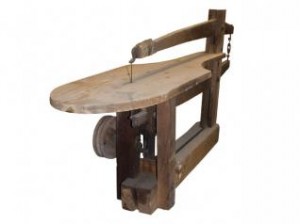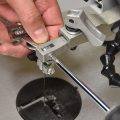 A photo-illustrated look at the origins of this popular woodworking tool
A photo-illustrated look at the origins of this popular woodworking tool
A lack of accurate record keeping shrouds the origins of the scroll saw in a veil of mystery. However, recently discovered records suggest the first patent for a saw using a reciprocating steel blade was awarded in 1829 in Great Britain.
Part of the reason researchers have such a difficult time nailing down the early history of the scroll saw is due to confusing and interchangeable terms. In the past, the term fretwork was used to describe all intricate and detailed cuts made in wood. While this form of woodworking can be traced back to some of the world’s earliest civilizations, until the 1500s, these types of projects were most likely cut with knives.
Big Book of SS Woodworking | Creating Wooden Boxes
Early Documentation of the Scroll Saw
In the 1500s, a German craftsman developed a way to make fine narrow saw blades. A French workman named Boulle developed a frame to hold these blades in order to cut intricate designs. The frame, called a Buhl saw, looks similar to today’s fret and coping saws. The Buhl saw made the cutting of intricate designs popular throughout Europe.
While there is some evidence to suggest the concept of using thin blades in a reciprocating machine was in practice before the 1800s, the first recorded patent for this type of machine was issued to Mr. M’Duff in 1829. According to The Register of Arts and Journal of Patent Inventions, on Dec. 2, 1829, Mr. M’Duff was awarded the Dr. Fellowes’ Annual Prize for the best machine invented by a working member of the London (England) Mechanics’ Institution.
According to the publication, “The machine for which the prize on this occasion is awarded, is professedly for the object of cutting out Buhl-work, with more facility and accuracy than by the means heretofore in use.”
The publication said Mr. M’Duff used his machine to cut the American continent out of a map of the world “with surprising rapidity and accuracy.”
The publication further states, “(Mr. M’Duff’s tool)consists of a very fine and delicate straight saw blade, fixed vertically in a suitable frame, which receives a reciprocating rectilinear motion from the rotary action of the lathe. This conversion of the line of motion is effected by a contrivance particularly deserving of notice from its extreme simplicity and cheapness.”
N American Wildlife Patterns for the SS | The Scroll Saw A Beginner’s Guide – DVD
The Evolution of the Scroll Saw
By 1857, there are at least three patents for improvements to the scroll saw and another patent references it as an American invention that was displayed at the 1851 Exhibition at the Crystal Palace in London. One document mentions the inventor attached a rod to the wheel of a band saw to drive another blade to be used as a scroll saw. By the 1860s, the first mechanical powered scroll saws began to appear in the United States using a foot-powered treadle, a hand crank, or a pedal mechanism.
During the Victoria Era (1850-1910), scroll saws were used to cut the delicate ornamental gingerbread patterns at the gabled ends along roof eaves and porches. Scroll saws were also used to create clocks, wall plaques, picture frames, and ornate furniture to adorn the inside of the home. By the 1920s, the term scroll saw was in common use throughout America and manufacturers, such as Barnes, New Rogers, Star, Lester, and Hobbies, began mass-producing them.
Intarsia Woodworking for Beginners | Wooden Bowls from the Scroll Saw
The Largest Known Scroll Saw Collection
Lifelong woodworker Rick Hutcheson wants to document the 180-year evolution of the scroll saw from the first patent in 1829 to today’s modern saws. Rick has one of the largest known collections of scroll saws from around the world, consisting of more than 200 saws.
Rick began his collection in 1995 with an old 1876 Barnes No. 7 treadle scroll saw he bought from a friend.
It has a big boat paddle you step on to operate it,” Rick said. “I paid $400 for it and actually sawed on it a few times for the novelty of it. Then I just thought to myself, ‘Hey, I’d like to start a collection.’ So I did.”
Today, that first antique scroll saw proudly sits alongside the others in what has grown to become Rick’s scroll saw museum, situated in a large room over his workshop in Grimes, Iowa.
Since his first purchase, Rick launched a relentless hunt for older, more unusual scroll saws of all types; treadle, pedal, hand-crank, pneumatic, water-powered, electric, homemade, manufactured, children’s saws, floor models, tabletops, and anything else that might fill the remaining gaps in his considerable collection.
In 2000, Rick began buying scroll saws over the Internet and through eBay.
“When I’d post the photos of my new saws on the web, people would contact me to see if I’d be interested in an old saw they had,” Rick explained. From there, Rick’s collection grew to fill his display floor and the shelves lining the walls.
“Now I’m having to stack them on top of each other!” Rick said with a laugh “I’ve always liked mechanical things. To me it’s just so neat to see how they were built, how they functioned, how many different types and styles there were, and how they all operated. It’s like the forensics of scroll saws.”
To preserve its antique value, each saw is kept in its original condition, smudges, dents, dings, missing parts, chips, broken saw blades, ratty cords, and all.
Despite the knowledge and resources Rick has accumulated during his search for saws, he still has very little information on some saws.
“With some of these saws, I have no idea who made it or what year it was made,” Rick said. “But then I’ll have someone go on my website museum and e-mail me that their grandfather had a saw exactly like that and he bought it new in 1932. If someone gives me that information, I gladly add it to my online museum.”
Rick never sells any of his saws, but he loves showing them off to anyone interested.
“I’ve had people from all across the country come here to see the saws,” Rick said. “Usually, they’ve been to my web page and want to see them in person or they’ll be passing through Iowa on vacation and decide to stop by. I’m only three miles off of the interstate. Come see me.”
These days, Rick is a little more particular about what he buys because he’s running out of room.
“It’s really got to be something different—something with a totally different type of drive system or a different blade-clamp setup,” Rick said, hopeful something unique will pop up. “I think there are still some surprises out there.”







